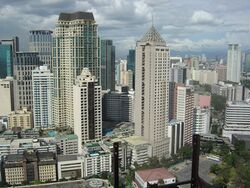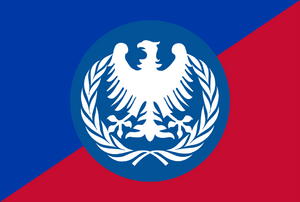New Phork
This article is incomplete because it is pending further input from participants, or it is a work-in-progress by one author. Please comment on this article's talk page to share your input, comments and questions. Note: To contribute to this article, you may need to seek help from the author(s) of this page. |
New Phork | |
|---|---|
 | |
| Motto(s): Good life, good death. | |
| Country | Philimania |
| Province | North Philimania |
| Founded | April 9, 1771 |
| Founded by | Henry Phork |
| Mayor–Council | New Phork City Council |
| Government | |
| • Mayor | Joseph Carr (Democratic Party) |
| Area | |
| • capital city | 1,320 km2 (510 sq mi) |
| • Urban | 990 km2 (380 sq mi) |
| • Rural | 330 km2 (130 sq mi) |
| Elevation | 10 m (30 ft) |
| Population (2020) | |
| • capital city | 1,865,432 |
| • Density | 1,413/km2 (3,660/sq mi) |
| • Urban | 1,096,980 |
| • Rural | 768,452 |
| Demonym | New Phorker |
| Time zone | UTC−6 (GMT-6) |
| Website | www.npc.gov |
New Phork, officially the The Republic of New Phork and colloquially referred to as NP, is a federal territory and the capital city of Philimania. It is the largest city in Philimania, covering an area of 1,320 km2 (510 sq mi) with an estimated population of 1.86 million as of 2020. Greater New Phork, is an urban agglomeration of 1.09 million people as of 2020. It is among the fastest growing metropolitan regions in South America, in both population and economic development.
New Phork is the cultural, financial and economic centre of Philimania. It is also home to The Philimanian Legistlative Council (TPLC). It first developed as a town serving the tin mines of the region circa 1771, before it became the capital of Philimania in 1773.
New Phork has a comprehensive road system supported by an extensive range of public transport networks, known as the New Phork Integrated Transit System. It was ranked as being the 9th most-visited city in the world in 2020 by Mastercard.
History
Etymology
The city is named after the founder who is called Henry Phork. The city of Phorktown was founded by his ancestors, Which is why the city is named 'New' Phork.
Early Years (1771-1790)
The city of New Phork was founded in 1771 by Henry Phork. Miners were involved in tin mining At the Philimanian east coast in the 1770s about four kilometres east of present-day New Phork. The City was originally a small hamlet of just a few houses and shops at the confluence of the Brades River before it grew into a town. It is generally accepted that become established as a town circa 1776, when the brother of Henry Phork, Philip Phork, raised funds from businessmen to hire some miners from Phorktown to open new tin mines here.
Although the early miners suffered a high death toll due to the malarial conditions of the jungle, the tin mines were successful, and the first tin from these mines was exported in 1790. The town, spurred on by tin-mining, started to develop centred on Old Market Square (Milieunt Ita), with roads radiating out towards The mines where miners also started to settled in. The miners formed gangs among themselves; and fights between different gangs were frequent in this period, particularly between factions of New Phork, mainly to gain control of the best tin mines.
Beginning of modern day New Phork (1790-1900)
By 1798, New Phork was most prosperous town in Philimania, attracting tons of people from smaller communities to come and find work meaning that more houses had to be built, the town started to grow very rapidly. By 1803, the town has become a city. In 1867, a railway line between New Phork and the mines on the east coast was built, increasing accessibility which resulted in the even more rapid growth of the city. The population grew from 86,672 in 1867 to 320,000 in 1880. As development intensified in the 1880s, it also put pressure on sanitation, waste disposal and other health issues. A Sanitary Board was created on 14 May 1890 which was responsible for sanitation, upkeep of roads, lighting of street and other functions. This would eventually become the New Phork City Council. In 1899, New Phork was made capital of Philimania by Mahad Sanders.
Present day (1900-Present)
By 1916, the city of New Phork has became one of the most largest and important cities in the world. In 2002, Foster International Airport was built by Huton Inc.. By 2010, New Phork is the number one tourist destination in South America.


